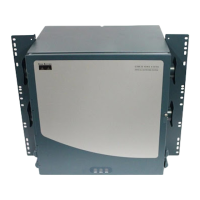18-5
Cisco ONS 15454 Procedure Guide, R5.0
March 2007
Chapter 18 DLPs A100 to A199
DLP-A117 Apply Alarm Profiles to Cards and Nodes
Note For more information about alarm suppression, see the “DLP-A522 Suppress Alarm Reporting”
task on page 22-17.
Current conditions are shown with the severity chosen in the alarm profile, if used. For more information
about alarm profiles, see the “NTP-A71 Create, Download, and Assign Alarm Severity Profiles”
procedure on page 7-7.
Note When a port is placed in the Out-of-Service and Management, Maintenance (OOS-MA,MT)
service state, it raises an Alarms Suppressed for Maintenance (AS-MT) condition. For
information about alarm and condition troubleshooting, refer to the Cisco ONS 15454
Troubleshooting Guide.
Step 3 If you want to apply exclusion rules, check the Exclude Same Root Cause check box at the node or
network view, but do not check the Exclude Same Root Cause check box in card view.
An exclusion rule eliminates all lower-level alarms or conditions that originate from the same cause. For
example, a fiber break might cause a loss of signal (LOS) alarm, an alarm indication signal (AIS)
condition, and a signal failure (SF) condition. If you check the Exclude Same Root Cause check box,
only the LOS alarm will appear. According to Telcordia GR-253, exclusion rules apply to a query of all
conditions from a node.
Step 4 Return to your originating procedure (NTP).
DLP-A117 Apply Alarm Profiles to Cards and Nodes
Step 1 In node view, click the Provisioning > Alarm Profiles > Alarm Behavior tab (Figure 18-3).
Purpose This task applies a custom or default alarm profile to cards or nodes.
Tools/Equipment None
Prerequisite Procedures DLP-A518 Create a New or Cloned Alarm Severity Profile, page 22-9
DLP-A60 Log into CTC, page 17-66
Required/As Needed As needed
Onsite/Remote Onsite or remote
Security Level Provisioning or higher

